Scania AB Bundle
Who Really Calls the Shots at Scania AB?
Ever wondered who steers the massive trucks and buses of Scania AB? Understanding the Scania AB SWOT Analysis and its ownership is key to grasping its market dominance and future trajectory. From its roots in Swedish innovation to its current global footprint, Scania's ownership story reveals a fascinating evolution. This deep dive explores the intricate details of who owns Scania and how it impacts the company's strategic direction.
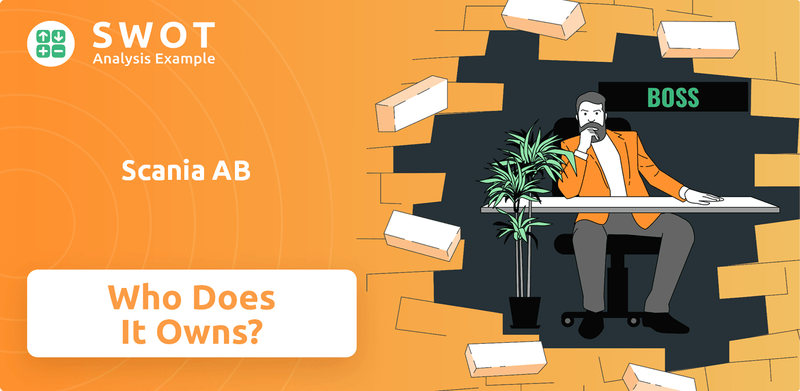
The journey of Scania AB's ownership is a compelling narrative of corporate evolution, shaped by strategic acquisitions and shifts in the automotive landscape. From its origins as a publicly listed entity to its current status within the Volkswagen Group, understanding the Scania parent company provides critical context for investors and industry observers. This exploration will uncover the key players, historical milestones, and current ownership structure that define the future of Scania trucks and its impact on the global commercial vehicle market. Who is the current owner of Scania AB?
Who Founded Scania AB?
The story of Scania AB Ownership begins with a merger. It's a tale of two Swedish companies coming together to form a powerhouse in the automotive industry. Understanding the founders and early ownership provides crucial context for the company's subsequent development and current structure.
Scania's roots are firmly planted in the late 19th and early 20th centuries. The merger of Vabis and Scania in 1911 marked a pivotal moment, laying the groundwork for the company's future. This union was essential for consolidating resources and expertise.
Vabis, founded in 1891, initially focused on railway wagons. Scania, established in 1900, initially manufactured bicycles before transitioning to automobiles and trucks. This merger was a strategic move to combine strengths and navigate financial challenges.
Vabis was established on December 11, 1891, in Södertälje, Sweden. It was founded by Philip Wersén and Surahammarsbruk.
Engineer Gustaf Erikson joined Vabis in 1896, playing a key role in expanding its product range. The first Vabis truck was presented in 1903.
Maskinfabriks-aktiebolaget Scania was founded in Malmö in 1900. It began with bicycles and quickly moved into vehicle production, launching its first series in 1902/03.
The merger of Vabis and Scania in 1911 formed Scania-Vabis AB. Engine and car production went to Södertälje, while truck production initially remained in Malmö.
In 1921, the Wallenberg family, through Stockholms Enskilda Bank, provided crucial financial support. They became significant stakeholders.
Early financial difficulties prompted the intervention of the Wallenberg family. This support was critical in stabilizing the company.
The ownership structure of Scania AB has evolved significantly since its inception. The merger in 1911 created Scania-Vabis AB, but the specific initial equity splits are not readily available. The Wallenberg family, through Investor AB and various charitable foundations, played a crucial role in the company's early years, providing financial stability and becoming significant shareholders. The Growth Strategy of Scania AB has been shaped by these early ownership dynamics.
- Who owns Scania is currently the Volkswagen Group.
- Scania parent company details show that it is a subsidiary of the Volkswagen Group.
- The Volkswagen Group acquired a controlling stake in Scania in 2008.
- As of the latest reports, the Volkswagen Group holds a significant majority of the shares.
Scania AB SWOT Analysis
- Complete SWOT Breakdown
- Fully Customizable
- Editable in Excel & Word
- Professional Formatting
- Investor-Ready Format
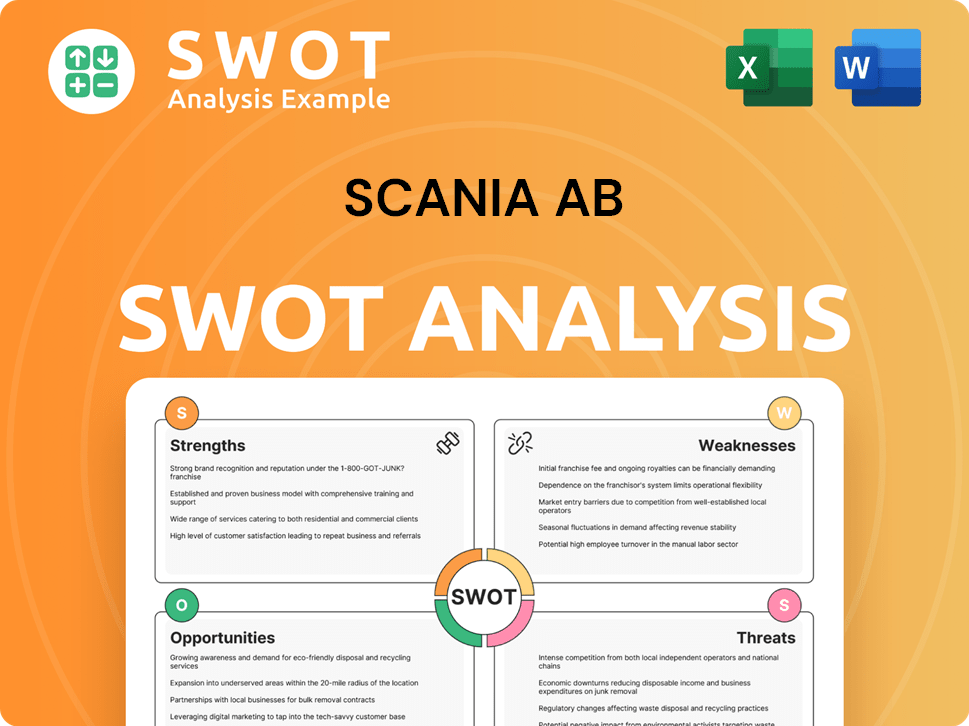
How Has Scania AB’s Ownership Changed Over Time?
The ownership of Scania AB has seen considerable changes since its inception. The Wallenberg family played a crucial role early on, becoming a significant shareholder after investing in 1921. Later, in 1969, Scania-Vabis merged with Saab AB, forming Saab-Scania AB. This entity operated as an independent business unit until 1995. Following the de-merger, the truck and bus division was renamed Scania AB and was listed on the Stockholm Stock Market in 1996. Initially, Investor AB offered shares to the market, reducing its stake.
A major shift occurred in 1999 when Volvo attempted to acquire a majority stake, but the European Union blocked the merger due to competition concerns. This led to Volkswagen AG's increasing involvement. Volkswagen acquired a significant stake in April 2000 and steadily increased its holdings. By March 2008, Volkswagen reached an agreement with the Wallenbergs to acquire their shares, and by July 2008, Volkswagen Aktiengesellschaft increased its share of voting rights to approximately 69%. By January 1, 2015, Volkswagen Group controlled 100% of the shares in Scania AB, making it a wholly-owned subsidiary. Understanding the Target Market of Scania AB can help in understanding the company's strategic direction.
| Year | Event | Impact on Ownership |
|---|---|---|
| 1921 | Wallenberg family investment | Became a major shareholder |
| 1969 | Merger with Saab AB | Formation of Saab-Scania AB |
| 1996 | Scania AB listed on Stockholm Stock Market | Public offering of shares |
| 1999 | Volvo merger attempt blocked | Paved the way for Volkswagen's involvement |
| 2000 | Volkswagen acquires shares | Volkswagen becomes a major shareholder |
| 2008 | Volkswagen acquires Wallenberg shares | Volkswagen increases voting rights to approximately 69% |
| 2015 | Volkswagen Group controls 100% of shares | Scania AB becomes a wholly-owned subsidiary |
Currently, Scania AB is a wholly-owned subsidiary of TRATON SE, which is itself a subsidiary of Volkswagen AG. TRATON SE is listed on the Frankfurt Stock Exchange and the Nasdaq Stockholm Stock Exchange. This means that the Volkswagen Group is the ultimate parent company and major stakeholder of Scania. The TRATON Group, which also includes brands like MAN and Navistar, aims to achieve industrial scale effects and drive sustainable transport solutions. As of 2024, Volkswagen Group's strategic focus includes expanding its electric vehicle offerings, which influences Scania's product development and market strategy.
Scania AB's ownership has evolved significantly, with Volkswagen Group now as the ultimate parent company.
- Volkswagen AG controls 100% of Scania AB shares.
- TRATON SE, a subsidiary of Volkswagen AG, is the direct parent company.
- The ownership structure reflects strategic shifts in the automotive industry.
- Scania AB is focused on sustainable transport solutions.
Scania AB PESTLE Analysis
- Covers All 6 PESTLE Categories
- No Research Needed – Save Hours of Work
- Built by Experts, Trusted by Consultants
- Instant Download, Ready to Use
- 100% Editable, Fully Customizable
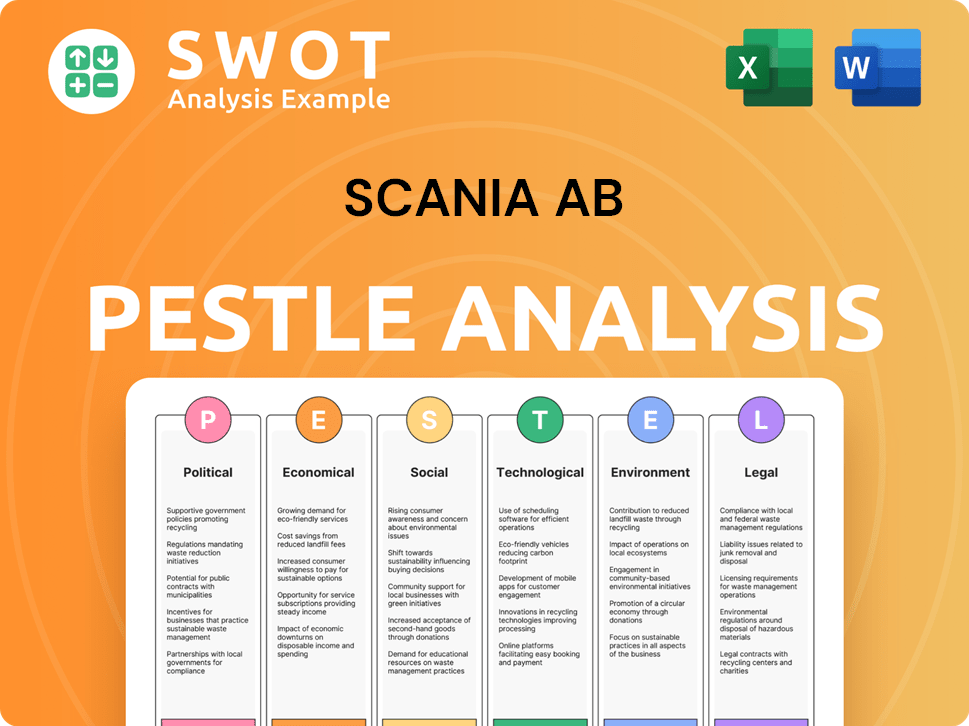
Who Sits on Scania AB’s Board?
The governance of Scania AB is straightforward due to its status as a wholly-owned subsidiary. The ultimate parent company is Volkswagen AG, with TRATON SE as an intermediate holding company. TRATON Sweden AB, an indirect subsidiary of TRATON SE, is the sole shareholder of Scania AB. This ownership structure places all voting power at Scania's Annual General Meeting (AGM) with TRATON Sweden AB.
The Board of Directors of Scania is elected by TRATON Sweden AB at the AGM. The board oversees the company's management, operations, and strategic direction. The board must have a minimum of three and a maximum of eleven members elected by the AGM, along with four employee representatives and two deputies. The current board members are not all publicly listed, but it's understood that representatives from the major shareholder (TRATON/Volkswagen Group) hold significant positions. The President and CEO, as of October 2024, is Christian Levin, who reports directly to the Board of Directors.
| Board Role | Description | Reporting Line |
|---|---|---|
| Board Members | Elected by the sole shareholder, TRATON Sweden AB. | Oversee the management, operations, and strategic direction of the company. |
| Employee Representatives | Four representatives and two deputies. | Represent employee interests. |
| President and CEO | Responsible for day-to-day operations and overall strategy. | Reports directly to the Board of Directors. |
The consolidated ownership structure within the TRATON Group, which is part of the Growth Strategy of Scania AB, eliminates complex voting arrangements. All decisions are made by the sole shareholder, TRATON Sweden AB. There have been no recent public reports of governance controversies, given the ownership structure. The ownership structure ensures decisions are streamlined within the Volkswagen Group.
Scania AB is a wholly-owned subsidiary of TRATON SE, which is part of the Volkswagen Group. This structure gives TRATON Sweden AB, the sole shareholder, complete control over voting rights. The Board of Directors is elected by the sole shareholder and is responsible for the company's management and strategic direction.
- TRATON Sweden AB holds all voting power.
- The Board includes members from the major shareholder and employee representatives.
- The CEO reports directly to the Board.
- There are no complex voting arrangements.
Scania AB Business Model Canvas
- Complete 9-Block Business Model Canvas
- Effortlessly Communicate Your Business Strategy
- Investor-Ready BMC Format
- 100% Editable and Customizable
- Clear and Structured Layout
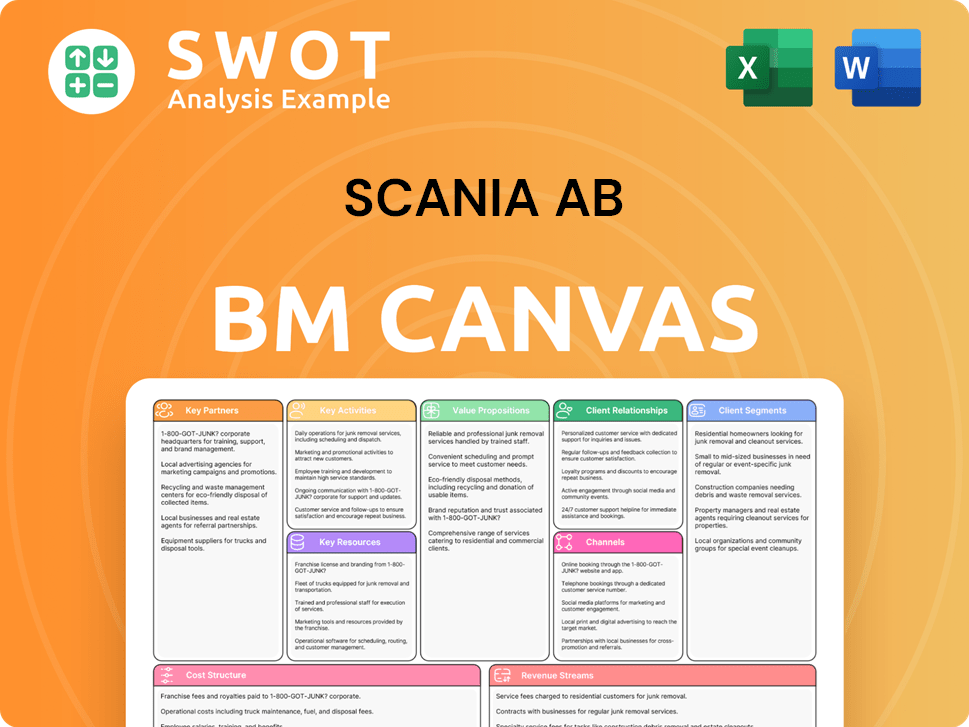
What Recent Changes Have Shaped Scania AB’s Ownership Landscape?
Over the past few years, the ownership structure of Scania AB has remained consistent. The company operates as a wholly-owned subsidiary of TRATON SE. TRATON SE is, in turn, part of the Volkswagen Group. This arrangement facilitates streamlined operations and quicker decision-making processes. It also helps to reduce administrative costs. The merger of MAN SE into TRATON SE in August 2021 further solidified Scania's position as a direct subsidiary of TRATON SE.
Recent developments at Scania focus on strategic advancements within this ownership framework, particularly in sustainable transport solutions. In 2024, Scania reported strong financial and operational performance. Net sales grew by 6% to SEK 216.1 billion. The adjusted operating income reached SEK 30.4 billion. Vehicle deliveries increased by 6% to 102,069 units. Deliveries of Zero Emission Vehicles (ZEV) amounted to 266 units. The company is heavily investing in research and development for electrification. It's also actively working to scale up battery-electric truck production.
Industry trends such as increased institutional ownership are less directly applicable to Scania, which is a privately held subsidiary. Instead, the focus is on the TRATON Group's overall strategy and how Scania contributes to it. TRATON aims to be a leader in the commercial vehicle industry, driving the shift towards sustainable transport. The company has committed €2.6 billion to e-mobility R&D from 2021 to 2026. Scania's role includes pioneering electric and autonomous vehicle technologies. Autonomous mining trucks are expected to begin operation in Australia from 2026. Scania is also expanding its supplier network for battery-electric trucks. Additionally, it's working to enhance charging infrastructure through initiatives like Erinion, which aims to provide 40,000 electric charging points in Europe by 2030. Public statements from Scania and TRATON emphasize continued investment in decarbonization and digital services, reinforcing Scania's integral role within the larger Volkswagen Group's commercial vehicle strategy.
Scania is a wholly-owned subsidiary of TRATON SE. TRATON SE is part of the Volkswagen Group. This structure allows for streamlined operations and strategic alignment within the larger automotive group.
In 2024, Scania saw a 6% increase in net sales, reaching SEK 216.1 billion. The adjusted operating income was SEK 30.4 billion. Vehicle deliveries also increased by 6% to 102,069 units.
Scania is prioritizing sustainable transport solutions. This includes investments in electrification, research, and development. The company is also expanding its network for battery-electric trucks.
Scania is working on autonomous vehicle technologies, with autonomous mining trucks planned for operation in Australia from 2026. The company is also investing in charging infrastructure.
Scania AB Porter's Five Forces Analysis
- Covers All 5 Competitive Forces in Detail
- Structured for Consultants, Students, and Founders
- 100% Editable in Microsoft Word & Excel
- Instant Digital Download – Use Immediately
- Compatible with Mac & PC – Fully Unlocked
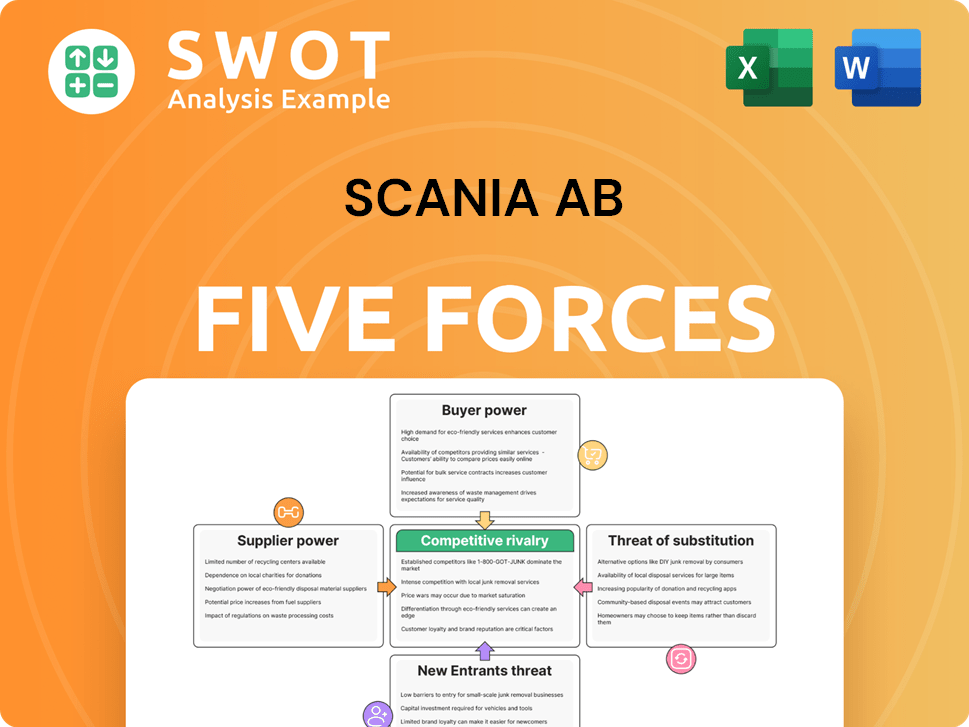
Related Blogs
- What are Mission Vision & Core Values of Scania AB Company?
- What is Competitive Landscape of Scania AB Company?
- What is Growth Strategy and Future Prospects of Scania AB Company?
- How Does Scania AB Company Work?
- What is Sales and Marketing Strategy of Scania AB Company?
- What is Brief History of Scania AB Company?
- What is Customer Demographics and Target Market of Scania AB Company?
Disclaimer
All information, articles, and product details provided on this website are for general informational and educational purposes only. We do not claim any ownership over, nor do we intend to infringe upon, any trademarks, copyrights, logos, brand names, or other intellectual property mentioned or depicted on this site. Such intellectual property remains the property of its respective owners, and any references here are made solely for identification or informational purposes, without implying any affiliation, endorsement, or partnership.
We make no representations or warranties, express or implied, regarding the accuracy, completeness, or suitability of any content or products presented. Nothing on this website should be construed as legal, tax, investment, financial, medical, or other professional advice. In addition, no part of this site—including articles or product references—constitutes a solicitation, recommendation, endorsement, advertisement, or offer to buy or sell any securities, franchises, or other financial instruments, particularly in jurisdictions where such activity would be unlawful.
All content is of a general nature and may not address the specific circumstances of any individual or entity. It is not a substitute for professional advice or services. Any actions you take based on the information provided here are strictly at your own risk. You accept full responsibility for any decisions or outcomes arising from your use of this website and agree to release us from any liability in connection with your use of, or reliance upon, the content or products found herein.